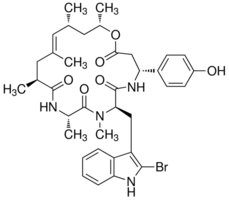
Jasplakinolide is an actin-specific reagent that promotes actin polymerization and stabilizes actin filaments. In vitro, Jasplakinolidet potently induces actin polymerization by stimulating actin filament nucleation and competes with phalloidin for actin binding (Kd = 15 nM). In vivo, Jasplakinolide has been found to disrupt actin filaments and induce polymerization of monomeric actin into amorphous masses, the exact mechanism of which has not been determined yet. Jasplakinolide differs from other actin stabilizers in that it is cell permeable. This peptide has fungicidal, insecticidal and antiproliferative activity, and is useful for investigating cell processes mediated by actin polymerization and depolymerization, such as cell adhesion, locomotion, endocytosis, and vesicle sorting and release.
| Molecular Weight | 709.67 |
| Formula | C36H45BrN4O6 |
| CAS Number | 102396-24-7 |
| Form | Solid |
| Solubility (25°C) | DMSO ≥ 2 mg/mL |
| Storage | -20°C, dry, sealed |
| Species | Mouse | Rat | Rabbit | Guinea pig | Hamster | Dog |
| Weight (kg) | 0.02 | 0.15 | 1.8 | 0.4 | 0.08 | 10 |
| Body Surface Area (m2) | 0.007 | 0.025 | 0.15 | 0.05 | 0.02 | 0.5 |
| Km factor | 3 | 6 | 12 | 8 | 5 | 20 |
| Animal A (mg/kg) = Animal B (mg/kg) multiplied by | Animal B Km |
| Animal A Km |
For example, to modify the dose of Compound A used for a mouse (20 mg/kg) to a dose based on the BSA for a rat, multiply 20 mg/kg by the Km factor for a mouse and then divide by the Km factor for a rat. This calculation results in a rat equivalent dose for Compound A of 10 mg/kg.
[5] A Holzinger. Jasplakinolide. An actin-specific reagent that promotes actin polymerization
| Related Actin-Related Protein Products |
|---|
| EG-011
EG-011 is a first-in-class, potent Wiskott-Aldrich Syndrome Protein (WASP) activator that activates the self-inhibited form of WASP via strong actin polymerization.In addition, EG-011 has selective anti-lymphoma activity. |
| Dihydrocytochalasin B
Dihydrocytochalasin B is a Cytokinesis inhibitor and changes the morphology of the cells, similar to that of cytochalasin B. |
| Cytochalasin B
Cytochalasin B is a cell-permeable mycotoxin binding to the barbed end of actin filaments, disrupting the formation of actin polymers, with Kd value of 1.4-2.2 nM for F-actin. |
| Cytochalasin D
Cytochalasin D is a cytopermeable actin polymerization inhibitor derived from fungi, which inhibits g-actin -- Cofilin interaction by binding g-actin. Cytochalasin D can also inhibit the binding of Cofilin to F-actin, reduce the release of exosomes and induce YAP phosphorylation. |
| SMIFH2
SMIFH2 is a fH2 domain inhibitor; prevents actin nucleation. |


Products are for research use only. Not for human use. We do not sell to patients.
© Copyright 2010-2023 AbMole BioScience. All Rights Reserved.
